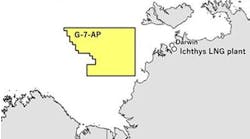Lake Maracaibo's depleted fields continue to produce
Result will depend on under-balanced drilling
William Furlow
Technology Editor
The Galileo barge is performing the first underbalanced drilling program on Lake Maracaibo.Venezuela's Lake Maracaibo is a very mature field. The lake is thick with wellheads crammed together, as one service company put it, like pins in a cushion. Still, with a little help from enhanced recovery techniques the lake is still able to produce and may be on the verge of a revival, according to Baker Hughes Solutions.
After the PDVSA second round, in late 1996, an increase in activity raced through Venezuela like a forest fire, fizzling out as oil prices dropped at the beginning of 1998. Javier Citelli, Business Development Manager for Schlumberger, estimates that activity has fallen off by as much as 30% from the rush, and attributes the slowdown to the drop in oil prices and a shortage of rigs on Lake Maracaibo. Because of the depleted reserves in these marginal fields, there is substantial up-front cost in the form of enhanced recovery technology. This investment in turn drives up production prices.
On the plus side of the Lake Maracaibo equation is the fact that with such a mature theater, there is substantial infrastructure already in place. The interaction of these two forces, low infrastructure costs, but high recovery expenses, translates to a country-wide cost of production Citelli estimates at $3/bbl.
While the overall production costs may be low, some areas, such as southern Lake Maracaibo, rely heavily on advanced technology to recover and process. Oil from this region, for example is heavily laced with hydrogen sulfide, requiring special handling that drives up costs. Activity in these areas is the first to fall off when prices drop and the rig market is tight.
Rig shortage
Citelli said earlier this year there was a serious rig shortage on the lake. There are 34 rigs, including 12 workover barges and 4 jackups. This is one situation he said might be helped by the ongoing slump in oil prices. As prices decline, PDVSA, the Venezuelan national oil company, will release some of its rigs to the market. These could then be contracted by the multinational organizations operating in the region. Currently, Schlumberger is having to make due with the rigs available and focus on work that does not require a rig.The jackups are a bit of an over-kill in water depths that do not generally surpass 100 ft. But there are frequent storms on the lake and the jackups must be disassembled to move under the bridge into the lake, so they are there to stay. These fixed-bottom rigs are used mostly for drilling new wells which range in depth from 12,000 ft to 19,000 ft.
Some companies have contracted for the construction of new rigs to be used in the lake. According to Citelli, Chevron has contracted Ensco to build three new barges specially designed for use in the lake.
Barges are generally preferred over jackups for most activity because of interference with pipelines on the lake bed. These rigs are limited to areas of the lake that are not densely developed.
Shallow water/deep wells
While some operators are emphasizing reentry and enhanced recovery work as the key to Lake Maracaibo's future, Citelli said others, such as Phillips Petroleum are looking at drilling deeper into the Cretaceous zone.The southern portion of Lake Maracaibo has faced limited interest from outside companies because of the asphaltenes that hamper production. According to Citelli, there are two basic hurdles to success in the southern portion of the lake. An operator would need a deep formation with enough fractures to produce the heavy oil and enough downhole pressure to avoid the asphaltenes. These wells are impossible to frac, Citelli said, because of the formation strength. It would take in the neighborhood of 25,000 psi to fracture them and the 5.5-in. casing at this depth can't stand the load.
The future
Moored in about 30 ft of water on Lake Maracaibo is the Baker Hughes Inteq Galileo barge. The vessel is the first of its kind, and there is another in The Netherlands, and a third in the works for Africa. Specifically, the system is being used on the lake for re-entry work. The vessel's reeled system was designed by BHI for wellbore construction.BHI's Galileo 2 drilled its first well at the end of 1997. The wells are drilled under balanced using 2 3/8-in. coiled tubing and slim hole MWD tools. Under-balanced drilling is critical because of the low formation pressures encountered on the lake. Drilling under balanced, or at formation pressure, reduces the damage to the formation from the invasion of drilling fluids. To do this, a conventional rig will usually re-enter the well, drill the window, and start the deviational build of the hole using aerated mud. Galileo 2 will then move onto location and drill out the horizontal section under balanced to TD. Under balanced drilling is achieved by using a foam system as a mud. The foam is generated using nitrogen.
An under-balanced choke system maintains the bottom-hole pressure and controls the flow of foam back to the under-balance system. Returns are broken down, gas separated, oil and cutting separated, and the foam's base fluid returned to the mud pits.
The Galileo 2 has the ability to run jointed pipe whenever required by using a "travel joint". The travel joint is run through the injector in the same manner as the coiled tubing. At the lower end a hook and bails are attached. The jointed pipe is then run in the conventional way. This method enables BHI to run the completion string when the well has been TD'd. This gives them the ability to mill windows etc. using drill pipe and a power swivel. This system is not used for under balanced work.
Small cement jobs can be done using the rig's equipment; however, larger jobs are done using a cementing service barge. The drilling operation is controlled from an automated coiled tubing cabin that is situated next to the rig floor. BHI follows a zero discharge policy, so the cuttings, waste mud, and produced oil are shipped back for disposal on shore.
While this is the first under-balanced program to be used in the lake, BHI is confident that such drilling will be key to optimizing these depleted reservoirs in the future.
Copyright 1998 Oil & Gas Journal. All Rights Reserved.




